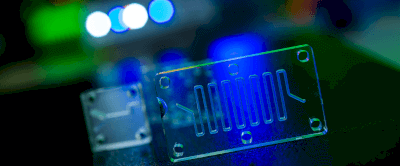What Is a Microdevice?
 A microdevice is a microchannel or reaction cell on a chip that is used for chemical reactions such as mixing, reaction, extraction, and phase separation of solutions.
A microdevice is a microchannel or reaction cell on a chip that is used for chemical reactions such as mixing, reaction, extraction, and phase separation of solutions.
Since the width of the channel is about a micrometer, the amount of reagent flowing through it can be kept small, and the reaction time can be shortened. The application of MEMS technology, described below, enables mass production of devices and the disposable use of used chips. This enables low-cost experiments and contributes to the development of academic fields such as chemistry and biochemistry.
Uses of Microdevices
Microdevices are used to perform various chemical and biochemical experiments using minute amounts of sample reagents.
The chip-like microstructure of microdevices enables the handling, observation, and cultivation of cells and microorganisms one by one. As a result, various biochemical properties of cellular tissues have been revealed.
Microstructures are also used to study the properties of droplets formed by mixing two different solutions (water, oil, etc.), and are expected to be applied to biology and other fields.
Principle of Microdevices
Microdevices are microfabricated microchannels or reaction cells created on a chip using a microfabrication technique called MEMS.
MEMS stands for Micro-Electro-Mechanical System and is applied to semiconductor integration technology. Various structures are created by applying techniques such as etching, UV irradiation, and film deposition. In addition, chemical reactions and heat treatment are combined to enhance the precision of processing. These technologies enable the creation of micrometer- to sub-micrometer-scale fine structures on substrates.
In the case of electronic devices, sensors, actuators, and circuits are integrated on silicon substrates. This has led to the development of accelerometers for use in cars and mirror devices for displays. Microdevices also emerged from these advanced integration technologies.
The creation of flow paths can be done arbitrarily, and depending on the usage of the device, parallel processing at high speed or sequential processing of multiple processes can be performed, making it a device that can be applied to various academic studies.